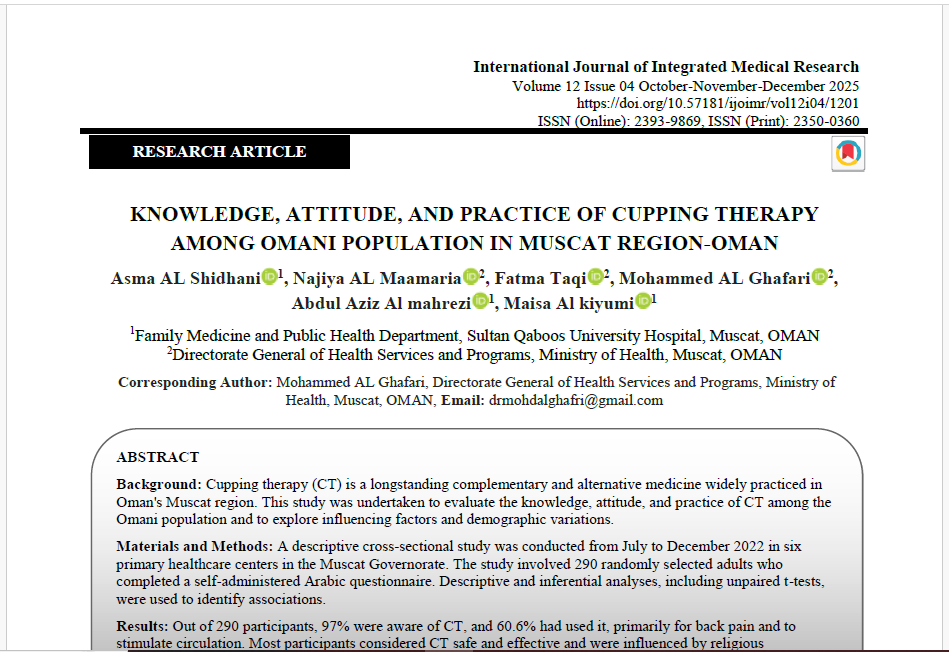A Knowledge, Attitude, and Practice of Cupping Therapy among Omani Population in Muscat Region-Oman Cupping Knowledge in Oman
Main Article Content
Abstract
Background: Cupping therapy (CT) is a longstanding complementary and alternative medicine widely practiced in Oman's Muscat region. This study was undertaken to evaluate the knowledge, attitude, and practice of CT among the Omani population and to explore influencing factors and demographic variations.
Materials and Methods: A descriptive cross-sectional study was conducted from July to December 2022 in six primary healthcare centers in the Muscat Governorate. The study involved 290 randomly selected adults who completed a self-administered Arabic questionnaire. Descriptive and inferential analyses, including unpaired t-tests, were used to identify associations.
Results: Out of 290 participants, 97% were aware of CT, and 60.6% had used it, primarily for back pain and to stimulate circulation. Most participants considered CT safe and effective and were influenced by religious endorsement. Higher knowledge was associated with higher education, while higher practice was linked to females and education. The main sources of information were family and friends.
Conclusion: Cupping therapy is prevalent in Oman, with generally positive perceptions, but gaps in understanding persist. The study suggests a need to promote evidence-based practices and the safe integration of CT with conventional medicine.
Article Details
References
References
Ghazi S. Knowledge, attitude and practice of cupping therapy among Saudi patients attending primary healthcare in Makkah, Kingdom of Saudi Arabia. Int J Med Sci Public Health 2016; 5:966–72. https://doi.org/10.5455/ijmsph.2016.02022016347.
Al-Yousef HM, Wajid S, Sales I. Knowledge, attitudes, and perceptions of cupping therapy (CT) in Saudi Arabia-a cross-sectional survey among the Saudi population. Biomed Res 2018; 29:3351–55.
Furhad S, Sina RE, Bokhari AA. Cupping Therapy. In: StatPearls [Internet]. Treasure Island (FL): StatPearls Publishing; 2024.
Zeid WA, Andersen JS, Kristiansen M. Patterns of complementary and alternative medicine use among Arab immigrants in Denmark: A qualitative study. Scand J Public Health 2019; 47:748–54. https://doi.org/10.1177/1403494818799597.
Ghazy EA, Al Muhayawi SM, Mourad SA, Alahdal RA. Comparison of Safety and Effi cacy of Al-Hijama (Cupping) and Conventional Medical Therapy for Sinusitis (I). J King Abdulaziz Uni Med Sci 2018; 25:11–25. https://doi.org/10.4197/Med.25-2.2.
Cao H, Li X, Liu J. An updated review of the efficacy of cupping therapy. PLoS ONE 2012; 7:e31793. https://doi.org/10.1371/journal.pone.0031793.
Yin J, Basch CH, Adnan MM, Fullwood MD, Menafro A, Fung IC-H. Attributes of Videos on YouTube Related to Cupping Therapy. Altern Ther Health Med 2018; 24:32–7.
Lee MS, Kim JI, Lee DH, Boddy K, Ernst E. Cupping for treating pain: A systematic review. Evid Based Complement Alternat Med 2011; 2011:497014. https://doi.org/10.1093/ecam/nep035.
Cao Z, Jiao L, Wang H, et al. The efficacy and safety of cupping therapy for treating of intractable peripheral facial paralysis: A protocol for systematic review and meta-analysis. Medicine (Baltimore) 2021; 100:e25388. https://doi.org/10.1097/MD.0000000000025388.
Choi TY, Ang L, Ku B, Jun JH, Lee MS. Evidence map of cupping therapy. J Clin Med 2021; 10:1750. https://doi.org/10.3390/jcm10081750.
Hong M, Lee IS, Ryu Y, Kim J, Chae Y. Cognitive and emotional aspects of cupping therapy. Brain Sci 2020; 10:144. https://doi.org/10.3390/brainsci10030144.
Lowe DT. Cupping therapy: An analysis of the effects of suction on skin and the possible influence on human health. Complement Ther Clin Pract 2017; 29:162–8. https://doi.org/10.1016/j.ctcp.2017.09.008.
Raja R, Kumar V, Khan MA, Sayeed KA, Hussain SZM, Rizwan A. Knowledge, Attitude, and Practices of Complementary and Alternative Medication Usage in Patients of Type II Diabetes Mellitus. Cureus 2019; 11:e5357. https://doi.org/10.7759/cureus.5357.
Al-Riyami H, Al-Maskari A, Nadar SK, Almaskari M. Knowledge, Attitudes and Practices Regarding Traditional and Complimentary Medicine in Oman. Sultan Qaboos Univ Med J 2023; 23:90–8. https://doi.org/10.18295/squmj.1.2022.007.
Aboushanab TS, AlSanad S. Cupping Therapy: An Overview from a Modern Medicine Perspective. J Acupunct Meridian Stud 2018; 11:83–7. https://doi.org/10.1016/j.jams.2018.02.001.
Alrowais NA, Alyousefi NA. The prevalence extent of Complementary and Alternative Medicine (CAM) use among Saudis. Saudi Pharm J 2017; 25:306–18. https://doi.org/10.1016/j.jsps.2016.09.009.
Khalil MKM, Al-Eidi S, Al-Qaed M, AlSanad S. Cupping therapy in Saudi Arabia: from control to integration. Integr Med Res 2018; 7:214–18. https://doi.org/10.1016/j.imr.2018.05.002.
Cage SA, Warner BJ, Gallegos DM, Winkelmann ZK. Perceived and Actual Knowledge of Cupping Therapy Concepts among Athletic Training Preceptors in CAATE Accredited Programs, Research & Investigations in Sports Medicine 2020; 6:514–18. https://doi.org/10.31031/rism.2020.06.000638.
Setyawan A, Hikmah IN, Oktavianto E, Saifudin IMMY. Anatomical points of cupping therapy for musculoskeletal pain: A systematic review. Nurse Media J Nurs 2022; 12:452–65. https://doi.org/10.14710/nmjn.v12i3.47082.
Eşitti BB, Güzel T. A Different Way of Increasing the Variety of Wellness and Health Tourism: Cupping Therapy (Hijama). Electronic Turkish Stud 2020; 15:3429–44.
Hong M, Lee I-S, Ryu Y, Kim J, Chae Y. Cognitive and emotional aspects of cupping therapy. Brain Sci 2020; 10:144.
Koran S, Irban A. Analytical approach to the literature of cupping therapy. Korean Soc Physical Med 2021; 16:1–14.
İnci H, İnci F. Complementary and alternative medicine awareness in cancer patients receiving chemotherapy. World Cancer Res J 2020; 7:e1752.
Wang Y-y, Fan H-w, Huang X-m, Jiao Y. Disseminated Staphylococcus aureus infection after scarification wet cupping therapy: a case report and literature review. BMC Complement Med Ther 2023; 23:94.
Wang X, Zhang X, Elliott J, Liao F, Tao J, Jan Y-K. Effect of pressures and durations of cupping therapy on skin blood flow responses. Front Bioeng Biotechnol 2020; 8:608509.
Hapipah H, Zulhan MI, Nadrati B. Wet Cupping Therapy to Reduce Total Cholesterol Levels in People with Diabetes. J Health Sci 2022; 15:46–51.
Xiao X-j, Zhang L-x, Shi Y-z, et al. Cupping therapy for patients with chronic urticaria: A systematic review and meta-analysis. J Integr Med 2020; 18:303–12.
Stephens SL, Lempke AFD, Hertel J, Saliba S. Clinical usage, application procedures, and perceived effectiveness of cupping therapy among healthcare professionals in the United States: A cross-sectional survey. Complement Ther Clin Pract 2022; 48:101610.
Wang L, Cai Z, Li X, Zhu A. Efficacy of cupping therapy on pain outcomes: an evidence-mapping study. Front Neurol 2023; 14:1266712.
Siregar R, Setyawan A, Syahruramdhani S. A model to standardize safety and quality of care for cupping therapy. J Integr Med 2021; 19:327–32.
